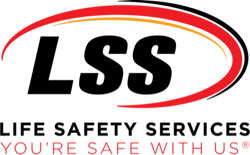
With the end of the year approaching it’s time to start planning for next year and preparing for your building’s fire and life safety inspections. As a professional in the fire and life safety industry, we are constantly urging that a building’s fire and life safety protection systems be properly maintained. This means both passive fire (fire/smoke dampers, fire doors, fire barriers) as well as active fire (sprinklers, fire extinguishers) protection systems must be working together and not one in place of the other. Photoluminescent egress path marking systems and exit signage are also an essential part of a building’s fire and life safety systems. In fact, both the International Building Code (IBC) and the International Fire Code (IFC) state, “luminous egress path markings that outline the exit path should be provided in buildings having floors that are located more than 75 feet above the lowest level of a fire department vehicle”. Otherwise, occupants may find it difficult to find the closest and safest exit path near them.
However, we’ve talk a lot about the importance of egress path markers. During a fire, smoke can quickly fill hallways and stairwells, making it dark and difficult to navigate. Egress path markers help guide occupants through the building to the closest and nearest safety in the event of a fire. However, egress exit signage is just as important as the egress path markers.
Egress signs should be placed in key locations throughout the facility to indicate the safe areas in which occupants can exit to. According to the National Fire Protection Association (NFPA) Life Safety Code 101, means of egress must be marked with egress signage, such as “Exit” signs in all the required areas. Exit signs must mark all exits and accesses to exits with visibly legible letters that are at least 4 inches tall. When the direction to safety is not clear, the sign must be marked with a chevron-shaped directional pointer. However, any door, corridor or stairwell that is not an exit or an access to an exit, and which could be mistaken for an exit, is to be identified by a sign reading “No Exit”. The word “No” must be at least 2 inches tall, while the word “Exit” must be 1 inch tall.
Other Codes That Require Egress Exit Signage:
- State of California Building Code – Chapter 10, Means of Egress requires in Group A, E, I, R-1, R-2 and R-3 Occupancies, in Exit corridors leading to Emergency Exit stairwells.
- State of Connecticut, Section 1026 – Requires in Group A, B, E, I-1, I-2, R-1 and R-2 occupancies, in Exit corridors leading to Emergency Exit stairwells.
- New York City Building Code —All non-residential structures
- New York City Local Law 26 Compliance
- General Services Administration (GSA) – Exit Path Markings
Benefits of Using Photoluminescence:
- Meets requirements for codes and standards in existing and new buildings
- PL exit signs can contribute to LEED Credits
- Require no electrical power or maintenance
- Doesn’t need to rely on any emergency backup system
- Glows up to 48 hours in smoky / black out condition
- Non-toxic or radioactive
There is nothing worse than being trapped in a building during a fire. And often times there is little to no warning that a fire has started. That’s why it is extremely important to not only make sure that all of your fire and life safety protection features are working and up-to-date with the codes, but that the proper egress is made, including egress signs! Since smoke rises, it can cause occupants to become disorientated and cloud their vision, making trips and falls are more likely to occur. So, photoluminescent strips create an outline of steps, landings, handrails and any other obstacles that could potentially cause someone to have an accident, while exit signs mark the quickest and safest way to evacuate.

